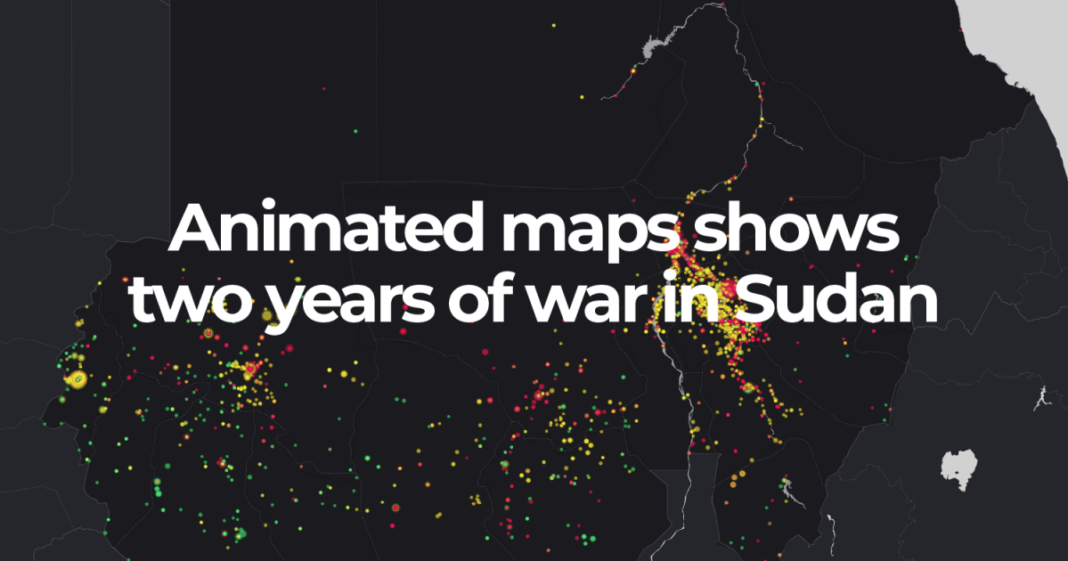Two years into the war in Sudan, the country remains engulfed in one of the world’s largest and fastest-growing displacement crises.
Since April 15, 2023, a brutal struggle for power between the Sudanese Armed Forces (SAF), led by Abdel Fattah al-Burhan, and the paramilitary Rapid Support Forces (RSF), commanded by Mohamed Hamdan “Hemedti” Dagalo, has turned cities into battlegrounds and forced more than 14 million people to flee their homes.
In recent weeks, the SAF has taken the capital, Khartoum, and forced the RSF to retreat.
More than 11,000 recorded attacks
From April 15, 2023, to March 28, 2025, at least 11,292 attacks were recorded, averaging 16 per day, according to the Armed Conflict Location & Event Data (ACLED) project.
According to it, Sudan’s army was behind 50 percent of all recorded attacks (5,615), while the RSF carried out 38 percent (4,291). The remaining 12 percent (1,386 attacks) were attributed to various other groups, including the Darfur Communal Militia, Darfur Arab Militia, Sudan People’s Liberation Movement, Twic Clan Militia, and others.
These attacks include armed clashes, air or drone strikes, shelling, artillery or missile attacks, looting or property destruction, and remote explosives or landmines.
The map below shows the geographical spread and intensity of conflict incidents across Sudan’s 18 states.
Nearly three-quarters of all attacks have centred around three main regions:
Khartoum
Sudan’s capital has been the epicentre, with 5,519 attacks, or 49 percent of all recorded incidents.
The army maintains its operations in and around the capital, saying it aims to dislodge the remaining RSF positions.
Gezira
Just south of Khartoum, Gezira – Sudan’s key agricultural state – has recorded 1,485 attacks, which is 13 percent of total incidents.
Once considered relatively stable, it became a key battleground as RSF forces expanded southwards.
North Darfur
In North Darfur, the RSF has launched several attacks on displacement camps and local militias. The region has seen 1,388 attacks – 12 percent of the national total.
Rest of Sudan
The remaining 26 percent of the fighting has been spread across the country, including:
- South Darfur: 511 attacks (5 percent)
- North Kordofan: 463 attacks (4 percent)
- West Darfur: 310 attacks (3 percent)
Tens of thousands of people killed
According to ACLED, at least 32,973 people have been reported killed across Sudan, though the actual death toll is likely much higher, especially when accounting for deaths caused by indirect reasons such as the spread of disease, malnutrition, and lack of adequate healthcare.
Half of the recorded deaths have occurred in Khartoum and North Darfur, which have the highest casualty rate.
Timeline of attacks
After months of rising tensions, on April 15, 2023, heavy gunfire and explosions erupted in Khartoum, a city of 10 million people. Gunfire was heard near key locations, including the army headquarters, the Ministry of Defence, the presidential palace, and Khartoum international airport.
By the end of August 2023, attacks reached their highest intensity, with 675 combined attacks recorded. The United Nations reported that one million people had fled the country, and internal displacement had exceeded 3.4 million.
Following a brief decline in attacks, violence again intensified in January 2024. By then, the UN reported that eight million people had been displaced by the war as famine loomed across the country.
In September 2024, the SAF carried out air raids against RSF positions in Khartoum, its largest assault in months.
A slight decline in the frequency of attacks was observed after January 2025. While violence remained concentrated in key regions, there was a brief respite from the intensity of earlier months.
Khartoum airport turned into aircraft graveyard
Using satellite imagery over the past two years, Al Jazeera’s fact-checking agency, Sanad, has mapped extensive destruction at Khartoum international airport.
Analysis reveals that the conflict has led to the destruction of at least 49 aircraft and severe damage to some 70 airport structures, including runways, infrastructure, and other facilities.

14 million people displaced
The UN says Sudan is facing the world’s worst displacement crisis, as the war continues with no end in sight.
More than 14 million people have been forced to flee their homes due to the ongoing conflict.
Of those, at least 11.3 million people have been displaced within Sudan, according to the latest figures from the International Organization for Migration (IOM).
At least three million people have crossed international borders, placing immense strain on neighbouring countries, including Chad, South Sudan, and Egypt.
Main regions of origin for displaced people:
- Khartoum: 3,500,400 displaced (31% of the total)
- South Darfur: 2,082,537 displaced (18%)
- North Darfur: 1,844,175 displaced (16%)
Main destinations for the internally displaced people:
- South Darfur: 1,837,706 displaced (16% of the total)
- North Darfur: 1,786,909 displaced (16%)
- River Nile: 935,723 displaced (8%)

